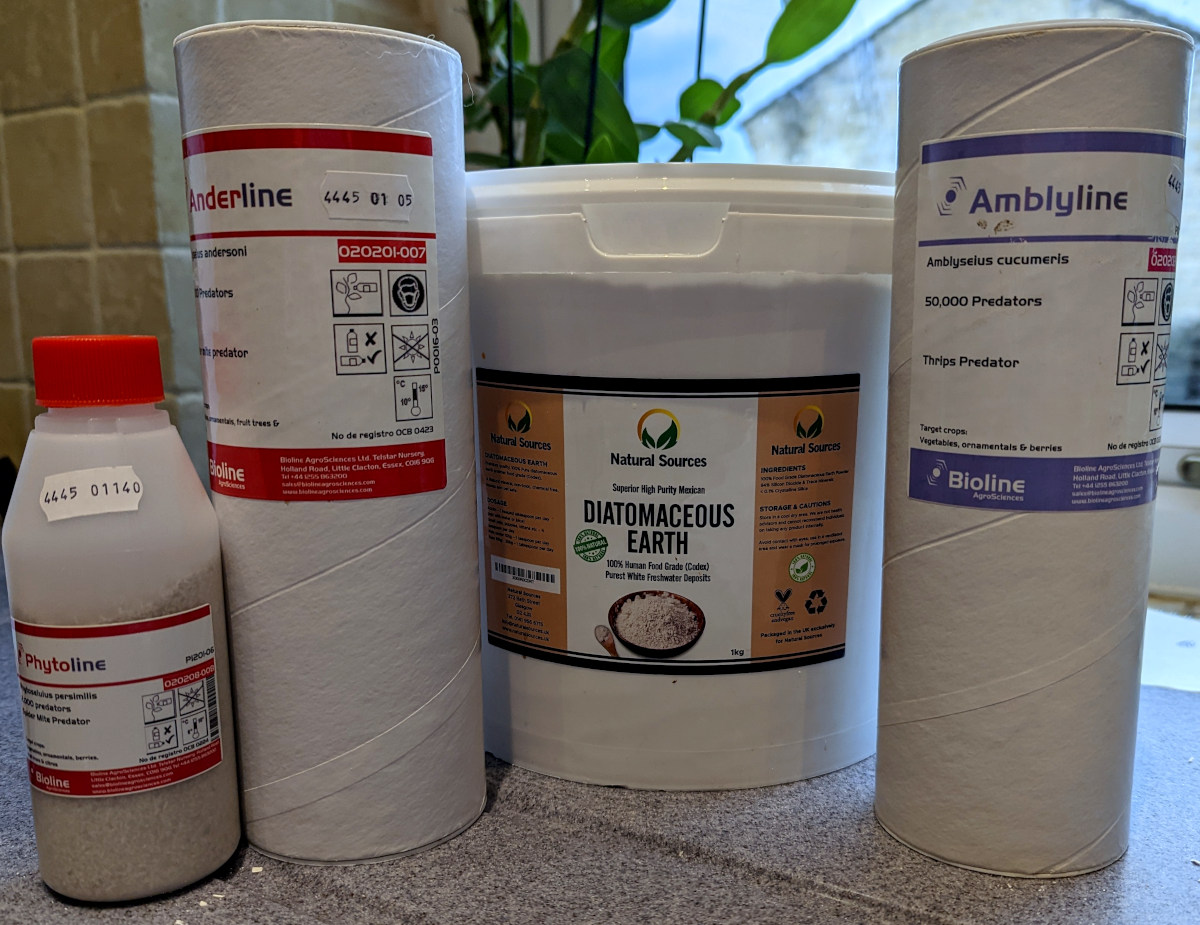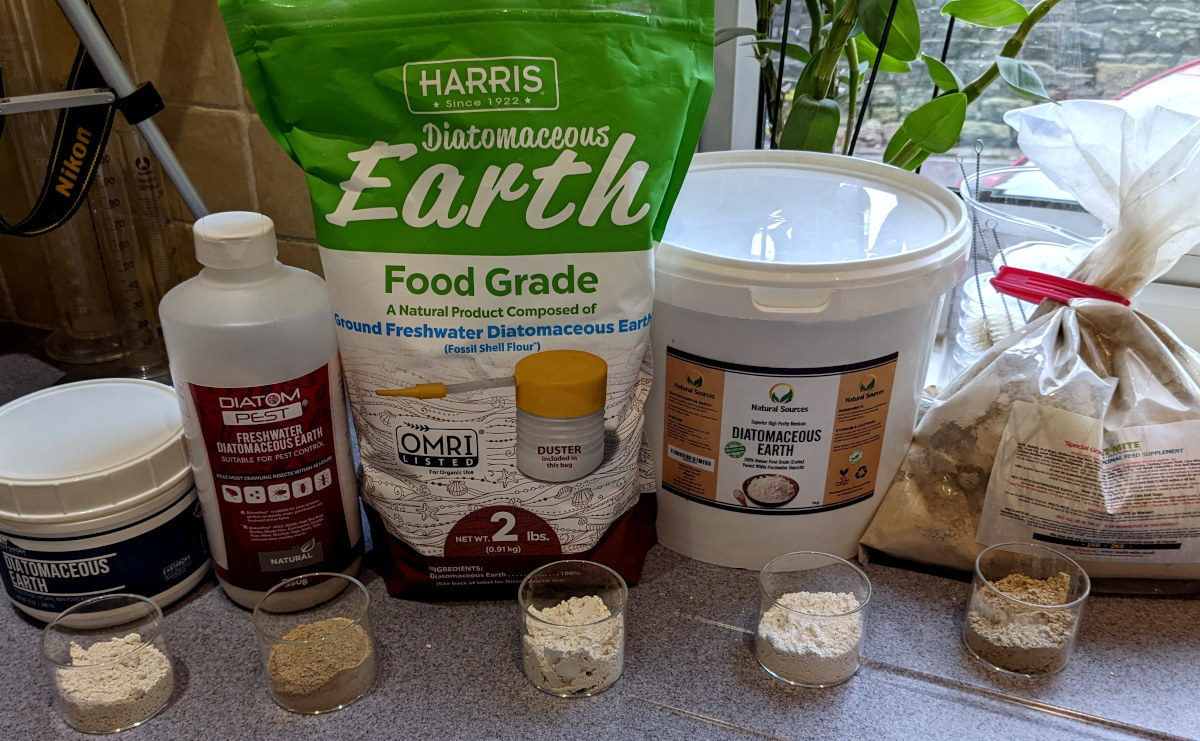I tested 5 brands of Diatomaceous Earth on more than a million insects and here is the results.

A real world experiment into the effectiveness of Diatomaceous Earth. Diatomaceous earth is a naturally occurring sedimentary rock formed from the fossilised remains of diatoms, a type of hard-shelled algae. It is a powdery substance that consists of the microscopic skeletons of these ancient organisms. This fine powder is highly absorbent and has abrasive properties.
Table of Contents
Diatomaceous Earth (DE) is a naturally occurring, soft sedimentary rock that crumbles into a fine powder.
How it works:
Diatomaceous earth is composed mainly of silica, a mineral that is essential for the growth and development of various organisms. It also contains small amounts of other minerals such as calcium, magnesium, and iron. The combination of these minerals gives DE its unique properties and benefits.
DE works as an insecticide in 2 ways, firstly by scratching the surface of the insect and locking the joints and secondly by absorbing the oils and fats from the cuticles of insects, causing them to dehydrate and die.
Below: DE gets into the joints of insects rendering them immobile and unable to move properly.
Any movement then scratches the exoskeleton exposing the inside to the elements and allowing the insect to dry out. This process is slow compared to chemical insecticides, but it is highly effective and, importantly, poses no risk of chemical exposure to humans or animals.
Unlike chemical insecticides, DE is a natural insecticide and is non-toxic to humans and pets, making it a popular DIY choice for those looking to manage pests without harmful chemicals.
The Experiment: DE vs. Insects:
Getting hold of the insects was the easy part, mites, thrips and predators can be bought in tubes of up to 50,000 at a time and insects are easily available live as food for reptiles kept as pets.
To truly understand the effectiveness of Diatomaceous Earth, I tested it on several types of insects commonly found in homes and gardens, including red mites, thrips, lice, crickets, flies, ants, cockroaches, fleas, and beetles.
Below: A video precis of one of the tests.
This test was on crickets, their ability to move was hindered immediately on application although it took 48 hours for all of them to die
How the experiment was carried out:
I applied a 3 gram sample of DE powder to a covered Petridish with a sample of the insects inside. The test was then repeated with each of the 5 brands of DE and the results recorded.
Below: The brands that were tested.

The results were filmed for up to 3 days until all the test subjects had died.
All brands were food grade DE and safe for do-it-yourself household use.
The Results:
Diatomaceous Earth is an effective natural pesticide, I found all five of the brands I tested to an effective insect killer.
Colour had no effect on the effectiveness of DE as a pesticide.
Every insect i tested was killed after the application of Diatomaceous earth although some took as long as 24 hours to die.
Below: Red poultry mite all dies within 24 hours of application. A 3 gram sample killed 5000 mites easily in the test container.
Below: A surprising result, DE also worked on mealworms, killing them within 48 hours.
This is one of the best examples of DE in action, you can see in the video how it has got into the joints between the section of the worm and locked them in place.
Of all the insects in our testing , roaches were by far the most resilient and took the longest to succumb.
Specific insect species DE recommendations:
Here's a list of common pests DE can combat, along with the best ways to use it for each:
Ants: DE can disrupt ants' exoskeletons, leading to dehydration. Best Use: Sprinkle a thin line of DE around entry points, ant trails, and nests. Reapply after rain or strong wind.
Fleas: DE can effectively kill fleas in all stages of life. Best Use: Apply DE to areas where pets spend time, such as bedding, carpets, and outdoor areas. Vacuum and reapply after a few days.
Bed Bugs: DE is effective at cutting and dehydrating bed bugs. Best Use: Lightly dust DE in cracks, crevices, and other hiding places where bed bugs are present. Leave it for several days, then vacuum thoroughly.
Cockroaches: DE can damage cockroaches' exoskeletons and dehydrate them. Best Use: Apply DE in areas where cockroaches are likely to travel, such as under appliances, behind cabinets, and along baseboards.
Mites: DE can be used to control poultry mites and other small pests. Best Use: Dust DE in the poultry coop, nesting boxes, and directly on birds to eliminate mites.
Lice: DE can help control lice infestations by dehydrating the insects. Best Use: Apply DE to animal bedding, grooming areas, and, if necessary, directly on the animal's fur or feathers.
Flies: DE can help manage fly larvae in areas with moist organic matter. Best Use: Spread DE in areas where fly larvae may develop, such as manure piles and compost heaps.
Ticks: DE can be effective in killing ticks by cutting their exoskeletons. Best Use: Apply DE around the perimeter of your yard, in areas where pets and livestock frequent, and directly on your pets if needed.
Spiders: DE can discourage spiders from taking up residence. Best Use: Dust DE in corners, around windows, and in basements or crawl spaces where spiders are found.
Silverfish: DE can eliminate silverfish by damaging their outer layer. Best Use: Sprinkle DE in areas where silverfish are seen, such as attics, basements, and under sinks.
Slugs and Snails: DE acts as a barrier that dehydrates these pests. Best Use: Create a ring of DE around plants, gardens, or other areas where slugs and snails are a problem.
Beetles: DE can kill beetles by absorbing their protective waxy layer. Best Use: Dust DE around the garden, in storage areas, or wherever beetles are spotted.
Earwigs: DE can eliminate earwigs by causing them to dry out. Best Use: Apply DE in areas where earwigs are found, such as flower beds, mulch, and damp outdoor spots.
Termites: DE can help manage termites by damaging their exoskeletons. Best Use: Dust DE around termite entry points, wood structures, and infested areas.
Maggots: DE can kill maggots by dehydrating them. Best Use: Sprinkle DE in trash bins, compost, or other areas where maggots are present.
For each of these pests, it's crucial to use food-grade Diatomaceous Earth, especially if applying it around food, living spaces or in the garden, and to reapply as needed after rain or cleaning, since moisture can reduce its effectiveness.
Below: Dusting flies with DE knocks the down immediately.
Pros and Cons of Diatomaceous Earth:
Pros:
- Non-Toxic: Safe for use around children and pets as a natural alternative to chemical pesticides.
- Long-Lasting: Remains effective as long as it stays dry.
- Environmentally Friendly: Does not harm the environment like some chemical insecticides.
- Easy to apply: DE need little specialist equipment to use safely.
Cons:
- Slow Acting: It may take several days to see results, particularly with tougher insects like cockroaches.
- Can be an irritant: DE is dusty, can dry the skin and irritate the lungs.
- Requires Reapplication: Needs to be reapplied after rain or in humid conditions, as moisture reduces its effectiveness.
- Can Be Messy: The fine powder can be challenging to clean up if over-applied.
After conducting these tests, I can confidently say that Diatomaceous Earth is a powerful tool in the battle against household and garden pests. While it requires patience and regular reapplication, its non-toxic nature and effectiveness make it an excellent option for those seeking a natural pest control solution.
